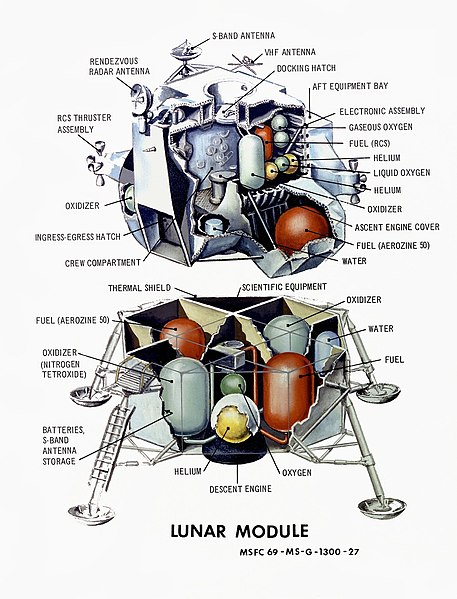While the question appears to have been thoroughly answered, I'd just like to welcome doodah to Space.com. Hope you enjoy your stay!
Also, seen as there is no oxygen in space, where is all the oxygen stored that is needed to burn the Aerozine-50???
In case you want even more information, burning a fuel requires the use of an oxidizer (not necessarily oxygen, but usually something containing oxygen atoms). In a rocket, the engine doesn't take any oxygen in from the atmosphere; that would be too slow to get the desired burn. (Crudely speaking, that's basically the difference between a rocket motor and a jet engine. They're both reaction motors, which is to say, they throw stuff out the back to make the engine go forwards, but the jet engine is airbreathing while the rocket carries all of its own oxidizer.)
If your chosen fuel is Aerozine-50 (or any other form of hydrazine), you will probably want to use nitrogen tetroxide as the oxidizer. The upshot of this combination is that you don't even need a spark -- it ignites as soon as the two liquids come into contact. Obviously, this makes it a very dangerous combination, but it's useful in space for two reasons. 1) these liquids don't boil off too easily (unlike cryogenics like liquid hydrogen) and 2) you don't need to worry about including an igniter, so your engine will be simpler and therefore less likely to fail. (In theory.) Another bonus of this propellant is that it is relatively dense, so you don't need as big of a tank to hold it. Nearly all satellites use this or a similar propellant combination for their onboard engines.
It does seem weird that Apollo needed a Saturn V to get off the Earth and onto a translunar trajectory, but only this tiny thing to get off of the Moon. But there's a reason for that, and it's the reason why NASA chose the lunar-orbit-rendezvous method. It ended up being cheaper and faster than designing an Earth-orbit rendezvous mission or a Moon direct mission (where the rocket leaves Earth and goes straight to a Moon landing). Basically, on the way up, they have to carry *everything* they'll need for the entire mission. But if they can throw things away partway in, they reduce the requirements for the remainder of the mission. So, they need enough energy to get a Saturn V off the ground on Earth, but they throw that Saturn V away, so they don't have to lift it again when they leave the Moon. This sort of mission profile might make an environmentalist wince, but in 1969, it was the most practical way to go, and indeed, still makes a lot of sense today.
Not long ago, NASA put together an awesome animation showing a Mars Exploration Rover from launch to rolling around on the Martian surface. It was released prior to the first MER launch, as an educational aid, but it ended up really driving home how much gets discarded. You watch the rocket take off. Then the first set of three solids falls away. Then the second set falls away. The payload fairing is jettisoned, and falls away. The first stage burns out and falls away. The second stage lights, then burns out, and, after spinning up the payload, falls away. The small spacecraft drifts silently towards Mars. Then, as it nears the Red Planet, the cruise stage is jettisoned, and the lander falls towards Mars. It enters the atmosphere. The backshell is jettisoned, and a drogue chute is deployed. Then this is jettisoned and the main chute is deployed. The heatshield is jettisoned. The pyramid-shaped landing platform drops down on a tether below the descent stage. Retrorockets fire to slow the descent stage, and the airbags inflate. The tether is cut, discarding the descent stage, and the lander falls to the Martian surface, bouncing a few times before settling. The bags deflate, and it opens to reveal the rover, righting itself in the process. The rover unfolds and rolls off the landing platform, never to see it again.
Almost the entire vehicle was discarded, piecemeal, to get that little robot to Mars. But it made sense to discard each piece. By throwing away the first stage, it wasn't necessary to boost the *entire* Delta rocket to Earth escape velocity, so less propellant was needed. The burned out upper stage wasn't necessary for getting lined up properly with Mars, so it was discarding, allowing the cruise stage to carry only a relatively small amount of propellant for adjusting the trajectory. The cruise stage wasn't needed for atmospheric entry, so it was discarded before entry, allowing the team to use a smaller heatshield and smaller parachutes. The descent rockets weren't needed for the actual landing, so they were placed in a separate descent stage, which reduced the mass of the thing bouncing around on the Martian surface enough that it wouldn't pop the airbags. And all those reductions in turn reduced the amount of propellant the original Delta rocket required.
Cool, huh? So although at the start of an Apollo mission, you need this great whopping monster of a rocket, by the end of the mission you don't need much at all.



